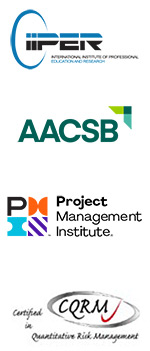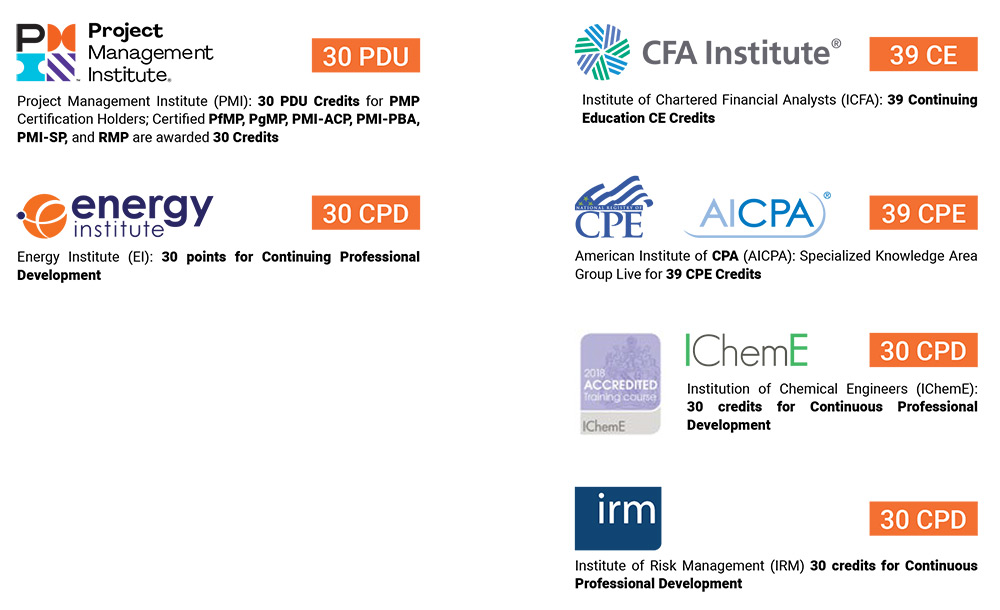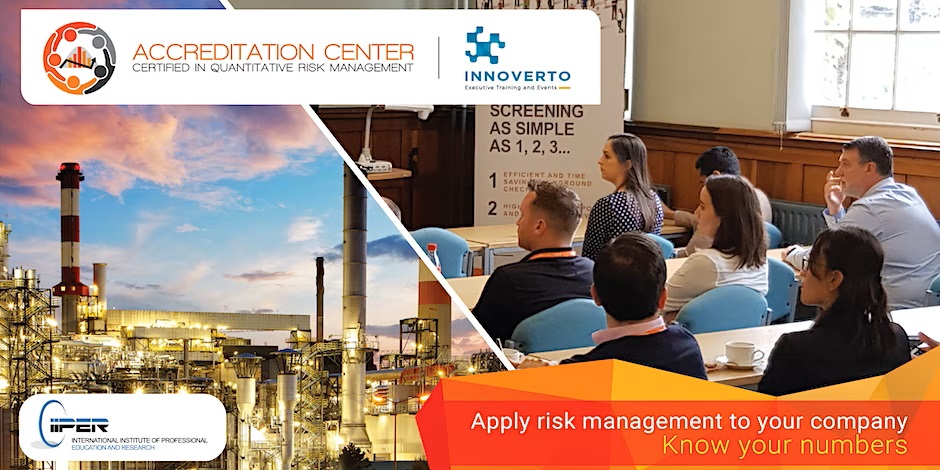Certified in Quantitative Risk Management (CQRM)

Overview
The CQRM helps professionals acquire updated and practical knowledge in risk management from a quantitative approach to measure, analyse and make decisions.
CQRM helps individuals to maximize and update their skills, knowledge, and experience in quantitative methods and risk management, ensuring clear paths to success within their current role and progression to future ones.
The CQRM skills and knowledge can be applied in different sectors such as Banking, Finance, Energy, Consulting, Mining, Health, Defence, Government, Research, Insurance, Infrastructure, Manufacturing, Logistics, among others.
Classroom
A 4-day intensive training program on Integrated Risk Analysis to complete the requisite in-class work and obtain the fully accredited CQRM designation.
In 8 Weeks, Online
By Investing 5-7 Hours per week you become CQRM qualifed. Complete Access to the materials, videos, excelmodels, case studies, and future updates.
“The CQRM course has shown me that Risk Management is more than what we usually know. The Certification in Quantitative Risk Management accreditation is not just the icing on the cake. It is the cake itself.”
MD (CEO) at Vanguard Life
George Kojo Addison
General Course Structure
PRE-CQRM FUNDAMENTALS
The PRE-CQRM covers fundamental topics in quantitative risk management, optimization, forecasting, and real options and helps you best prepare for the CQRM training and online examination.
CQRM LEVEL I
Helps to understand the theory and application of Monte Carlo Simulation, Applied Statistics, Linear and Nonlinear Correlation, Bootstrapping, and Model Analytics.
CQRM LEVEL II
Explores and covers the theory, application, and hands-on modelling of optimization as well as predictive modelling and forecasting, including Time-series models, Regression Analysis, ARIMA and GARCH models, and Stochastics Processes.
CQRM LEVEL III
This CQRM Level III course in Real Options Analysis covers the theory, application, case studies, as well as hands-on modelling and valuation of strategic real options.
CQRM REVIEW
This section reviews all material for the Certification course and exam. There are three 30-minute review sessions that will help you best prepare for the CQRM online examination.
CQRM EXAM
To help you prepare for the fnal exam, we offer practice questions and a mock exam. Then, in advance of the exam, take a mock exam, which mimics the CQRM exam experience as closely as possible.
“I found the CQRM course very informative and interesting. The whole program was run to perfection. I would defnitely recommend the course to others professionals, especially managers and decision makers.”
MD (CEO) at OSL Consulting Engineers
Alastair Robertson
Certification
Why attend this Certification?
 To be Certified internationally as a Quantitative Risk Manager (CQRMIIPER).
To be Certified internationally as a Quantitative Risk Manager (CQRMIIPER).
Take advantage of the opportunity to learn from world experts who have outstanding credentials and extensive practical experience in quantitative methods and risk management.
Understand how to make more informed decisions in times of uncertainty and achieve better business outcomes.
Update and immerse yourself in techniques that allow you to understand the past and the present and to more accurately forecast the future.
To model industry-specifc problems and implement risk analysis using Risk Simulator and Real Options SLS, capable of analysing large volumes of information and working with the latest implementation of risk management analytics.

Certification
CQRM is an international accreditation in quantitative risk management offered by the International Institute of Professional Education and Research (IIPER).
IIPER’s CQRM Certification is accredited by the National Certification Commission, and IIPER is a member of the AACSB (Association for the Advancement of Collegiate Schools of Business), one of the largest accreditation agencies of business schools worldwide.
The CQRM is endorsed by the Project Management Institute (PMI) allowing participants to obtain 30 professional development units (PDU) upon completion of the course. Completing a 4-day intensive training program on Integrated Risk Analysis is a requisite (in-class work) to obtain the fully accredited CQRM designation.
By participating in the CQRM, attendees will have elements to analyse and data to interpret for risk analysis, and will learn to understand the results obtained as well as make decisions based on the simulation tools, optimization, and real options techniques.
In accordance with the standards of the National Registry of CPE Sponsors, CPE credits have been granted
based on a 50-minute hour.
In accordance with the standards of the Project Management Institute, PDU credits have been granted as
specifed below.
In accordance with Continuing Education standards, CE credits are granted as specifed below.
In accordance with Continuing Professional Development standards, CPD credits are granted as specifed below.
In accordance with CPD, PDU and CPE Sponsors and accredited professional bodies, IIPER is committed to offering
high-quality continuing professional education.

CQRM helps individuals to maximize and update their skills, knowledge and experience in quantitative methods and risk management, ensuring clear paths to success within their current role and progression to future ones.
It enhances learning from colleagues or shared learning from networking, exploring new technologies, and applying new methods and analytics to make informed decisions.
CQRM combines theory and practice, case studies and applications, ideas and techniques that help professionals to manage their own learning and growth, and to perform competently in their day-to-day activities.
Topics & Framework
Level 1
MODULE 1: Introduction to Risk Analysis
Chapter 1: Introduction to the Training and What to Expect
Chapter 2: How Are Business Decisions Made?
Chapter 3: What Is Risk and Why Should Risk be Considered?
Chapter 4: Overview of Risk Analysis Software Applications
MODULE 2: Monte Carlo Simulation with Risk Simulator
Chapter 1: Overview of Risk Simulator Software
Chapter 2: Profiling, Assumptions, Forecasts, and Running Simulations
Chapter 3: Interpreting the Forecast Statistics
Chapter 4: Simulation Run Preferences and Seed Values
Chapter 5: Running Reports, Saving and Extracting Simulation Data
MODULE 3: Advanced Simulation Techniques
Chapter 1: Correlating and Truncating Distributions
Chapter 2: Alternate Parameters
Chapter 3: Multidimensional Simulations
Chapter 4: Distributional Fitting
Chapter 5: Due Diligence and Pitfalls in Simulation
MODULE 4: Simulation and Analytical Tools
Chapter 1: Static Tornado and Spider Charts
Chapter 2: Dynamic Sensitivity Analysis and Scenario Analysis
Chapter 3: Hypothesis Test on Different Distributions
Chapter 4: Nonparametric Bootstrap Simulation
Level 2
MODULE 5: Optimization with Risk Simulator
Chapter 1: Introduction to Optimisation
Chapter 2: Continuous Optimisation
Chapter 3: Integer Optimisation
MODULE 6: Forecasting
Chapter 1: Overview of Forecasting Techniques and Data Types
Chapter 2: Forecasting Without Data
Chapter 3: Time-Series Analysis Forecasting
Chapter 4: Nonlinear Extrapolation
Chapter 5: Multivariate Linear and Nonlinear Regression Analysis
Chapter 6: Stochastic Processes
Chapter 7: Advanced Forecasting: Box-Jenkins ARIMA and Auto ARIMA,
GARCH, J-Curve, S-Curves, Markov Chains, Data Diagnostics, Statistical
Properties, Basic Econometrics
MODULE 7: Real Options Analysis: Theory and Background
Chapter 1: Real Options: What, Where, Who, When, How, and Why?
Chapter 2: Sample Applied Business Cases
Chapter 3: Overview of Different Options Valuation Techniques
Chapter 4: Risk-Neutral Probability Technique
Chapter 5: Solving a Basic European and American Call Option
Chapter 6: Using Excel to Solve a Basic European and American Call Option
Chapter 7: Abandonment, Expansion, Contraction, and Chooser Options
MODULE 8: Real Options Analysis: SLS (Super Lattice Solver) Application
Chapter 1: Overview of the Different SLS Modules and Volatility Estimates
Chapter 2: Volatility Estimates
Chapter 3: Options with Changing Inputs and Customised Exotic Options
Chapter 4: MSLS: Multiple Sequential Compound Options
Chapter 5: MNLS: Solving Mean-Reverting, Jump-Diffusion, and Dual-Asset
Rainbow Options using Trinomial, Quadranomial, and Pentanomial Lattices
Chapter 6: Framing Real Options—Structuring the Problem
Chapter 7: The Next Steps…
CQRM REVIEW FOR THE EXAMINATION
CQRM EXAM
Dr. Jonathan Mun

DR. JOHNATHAN MUN
PH.D., MS, MBA, BS, CQRM, CRA, FRM, CFC, MIFC
CQRM | PROGRAM DIRECTOR
Prof. Dr. Johnathan Mun, Chairman of the IIPER, is the founder/CEO of Real Options Valuation Inc., and is responsible for the development of its suite of analytical software products, consulting, and training services.
As the software’s creator, with more than 12 patents and 10,000 pages of copyrighted materials, he teaches Risk Analysis, Real Options for Analysts, Risk Analysis for Managers, CQRM, and other courses. He has written over 20 books on the topic of risk management.
Dr. Mun has consulted on risk analysis, valuation, and real options for many Fortune 500 frms from 3M, Airbus, and Boeing to GE, Motorola, and the U.S. government including the Department of Defense as well as other state and federal agencies.
He was formerly Vice President of Analytics at Decisionering, Inc. (Oracle), and was a Consulting Manager in KPMG’s Global Financial Strategies practice.
Dr. Mun is also a full professor at the U.S. Naval Postgraduate School and a professor at the University of Applied Sciences and Swiss School of Management (Zurich and Frankfurt), and he has held other adjunct professorships at various universities.
He has a Ph.D. in fnance and economics, an MBA in business administration, an MS in the area of management science, and a BS in applied sciences. He is certified in Financial Risk Management (FRM), Certified in Financial Consulting (CFC), and Certified in Quantitative Risk Management (CQRM).
Free Webinar
CQRM Integrated Risk Management in Net-Zero and Decarbonization Strategies – FREE Webinar
In Net Zero and Decarbonization projects and investments, strong teams with Quantitative Risk Management skills and knowledge can help energy companies to address and manage business risks to battle climate change and greenhouse gas emissions.
This technical presentation, organised by INNOVERTO (UAE), OSL (UK), and IIPER (US), helps and clarifies how professionals can perform risk-option selection analysis using economic valuations and project risk management, and integrate them into a fully enterprise risk management framework for Net Zero and Decarbonization initiatives.
Therefore, this event also gives participants the opportunity to register their interest in the professional qualification Certified in Quantitative Risk Management (CQRM) INNOVERTO is hosting in Dubai this year.
The IIPER CQRM is one of the fastest-growing international qualifications recognized by a growing number of multiple international institutions. These currently include, among others, the Project Management Institute (PMI), the Institute of Risk Management (IRM), the Institution of Chemical Engineers (IChemE) and the Energy Institute, all of whom are providing from 30 to 45 CPD, PDU and CPE credits.
Join our free webinar on April 12, from 13:30 to 15:00 UAE Time
Included Material
 RS Risk Simulator
RS Risk Simulator
Powerful Excel add-in software used for applying simulation, forecasting, statistical analysis, decision trees, econometric analysis and optimisation in your existing spreadsheet models. Risk Simulator was developed specifcally to be extremely easy to use. For instance, running risk simulations is as simple as 1-2-3 (set an input, set an output, and run); and performing forecasting (e.g. autoeconometrics, GARCH models, stochastic processes, time-series, multivariate analysis) relies on simple clicks in the software. Users can effectively focus on analysis, reports and numerical results.
 SLS Real Options Super Lattice Solver
SLS Real Options Super Lattice Solver
Standalone software with also Excel addin capabilities for analysing and valuing real options, fnancial options, exotic options and employee stock options. All inputs could be incorporated into custom spreadsheet models, allowing the creation of your own à la carte fully customised models, where all the mathematical equations and functions are visible. Consequently, option valuations and results are easier to understand and explain, allowing users to value fnancial and real assets, thereby quantifying flexibility and mitigating uncertainty.
 Ebook: Advanced Risk Analytics
Ebook: Advanced Risk Analytics
Containing the slides that will be seen during the Certification, therefore, it is focused on learning the specifc ideas and methodologies that are developed in the International Certification in Quantitative Risk Management (CQRM).
“The most relevant and valuable course that I’ve ever attended. Quantitative Risk Management is central to business survival and growth.”
Senior Vice President at Mubadala
Dr. Adrian Deazle
Download Brochure and Articles
To learn more and view the course outline fill the form below to download the brochure and related articles.


